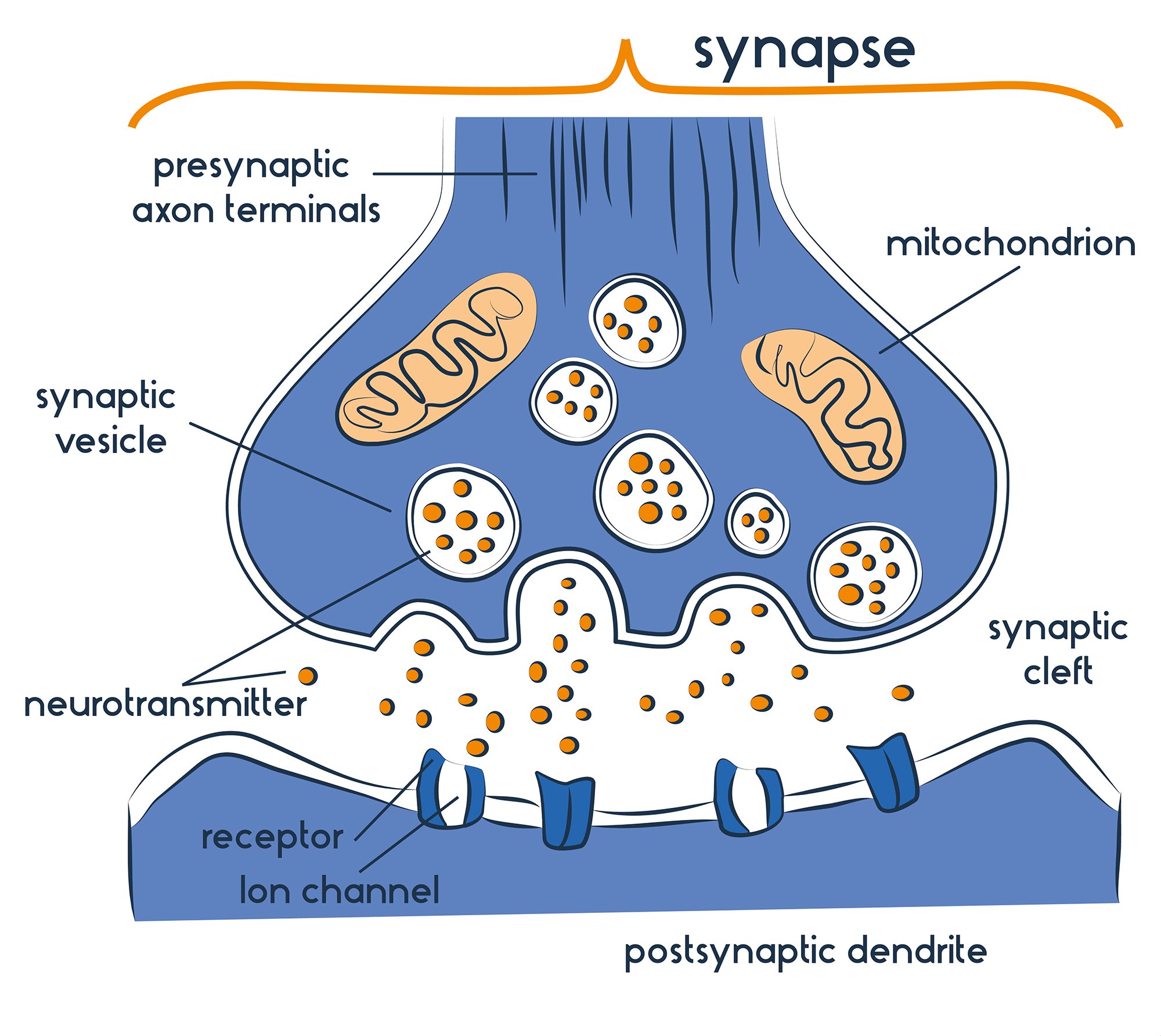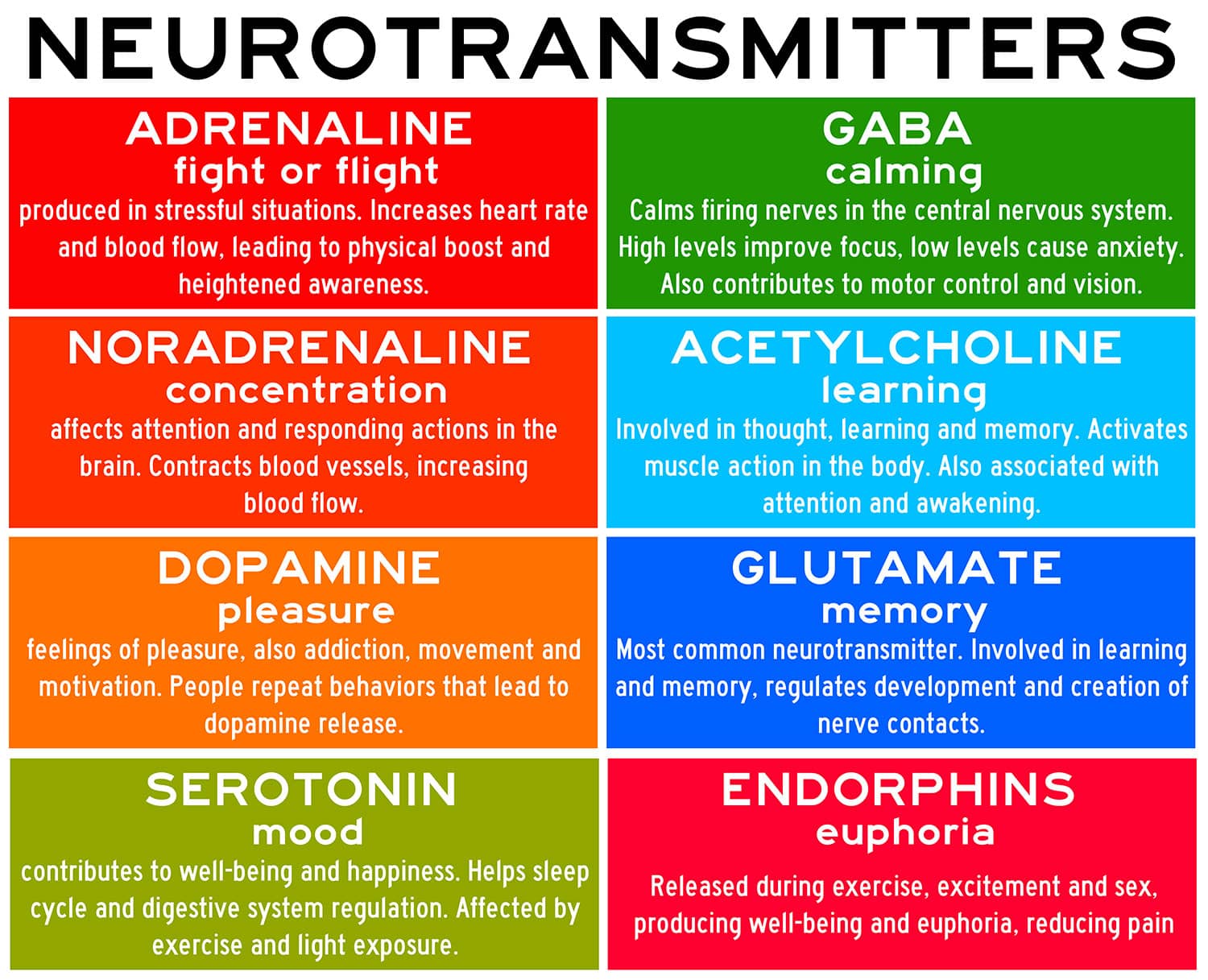Neurotransmitters are chemical messengers that play a vital role in how your brain and body communicate. They affect everything from your mood and memory to your heartbeat and breathing.

Key Takeaways
- Neurotransmitters are chemicals that help neurons communicate and regulate everything from mood to muscle movement.
- They are categorized as excitatory, inhibitory, or modulatory depending on how they affect brain activity.
- Common neurotransmitters like serotonin, dopamine, and GABA play critical roles in mental health and emotional balance.
- Many psychiatric medications and recreational drugs work by altering neurotransmitter activity.
- Healthy habits like exercise, sleep, and social connection can help support neurotransmitter function naturally.
What Are Neurotransmitters?
Neurotransmitters are chemicals that carry messages between nerve cells, also called neurons. When a signal travels through one neuron, it reaches the end of the cell and triggers the release of neurotransmitters.
These chemicals cross a tiny gap called the synapse and bind to receptors on the next neuron, passing the message along.
This process, called neurotransmission, helps control countless functions in your brain and body, including:
- Emotions and mood
- Sleep and alertness
- Learning and memory
- Pain and pleasure
- Breathing and heart rate
How Neurotransmitters Work
Below is a simple breakdown of how neurotransmitters work:
- Signal sent: An electrical impulse (action potential) travels down a neuron.
- Neurotransmitters released: This triggers chemical messengers to be released into the synapse.
- Message received: These messengers bind to receptors on the next neuron.
- Signal passed on or stopped: The receiving neuron is either activated (excited), calmed (inhibited), or influenced in more complex ways.
- Clean-up: Any leftover neurotransmitters are either broken down by enzymes or taken back up by the original neuron (a process called reuptake).

Types of Neurotransmitters
Neurotransmitters come in three main types, based on how they affect the receiving neuron:
- Excitatory: Increase the chance the next neuron will fire (e.g., glutamate, adrenaline).
- Inhibitory: Reduce the chance of firing, calming the system (e.g., GABA, serotonin).
- Modulatory: Fine-tune or adjust the activity of other neurotransmitters (e.g., dopamine).
Some neurotransmitters can be more than one type, depending on the situation or the receptors involved.
Key Neurotransmitters
Below are some of the key neurotransmitters and what they do:

Serotonin (Inhibitory)
- Regulates mood, sleep, appetite, and digestion
- Low levels linked to depression, anxiety, and insomnia
- Found in the brain and gut
Dopamine (Modulatory)
- Involved in pleasure, motivation, movement, and learning
- High levels linked to addiction and impulsivity
- Low levels linked to depression and Parkinson’s disease
Glutamate (Excitatory)
- Main excitatory neurotransmitter in the brain
- Crucial for learning and memory
- Too much can lead to neuron damage (e.g., in stroke or Alzheimer’s)
GABA (Gamma-Aminobutyric Acid) (Inhibitory)
- Main calming neurotransmitter
- Helps regulate anxiety, motor control, and sleep
- Low levels linked to anxiety, seizures, and mood disorders
Norepinephrine (Noradrenaline) (Excitatory)
- Triggers alertness, focus, and stress response
- Involved in the “fight-or-flight” reaction
- Imbalances linked to depression, anxiety, and attention difficulties
Epinephrine (Adrenaline) (Excitatory)
- Similar to norepinephrine, but more hormone-like
- Heightens alertness and prepares the body for action
- Associated with high blood pressure and stress
Acetylcholine
- Helps control muscles, memory, and attention
- Low levels linked to Alzheimer’s disease
Endorphins (Inhibitory)
- Natural painkillers that create feelings of pleasure or euphoria
- Released during exercise, excitement, or injury
Adenosine (Modulatory)
- Promotes sleep and relaxation
- Blocked by caffeine, which explains why coffee keeps you awake

Neurotransmitters and Mental Health
Many mental health conditions are linked to imbalances in neurotransmitters:
- Depression: Often associated with low serotonin, dopamine, or norepinephrine
- Anxiety: Linked to reduced GABA and imbalanced serotonin
- Schizophrenia: Involves overactive dopamine signaling
- ADHD: Often tied to low dopamine and norepinephrine levels
Understanding these links helps explain why medications target specific neurotransmitters to ease symptoms.
How Medications and Drugs Affect Neurotransmitters
Medications:
- SSRIs (like Prozac) block the reuptake of serotonin, keeping more in the brain
- Benzodiazepines (like Valium) enhance the calming effect of GABA
- Antipsychotics block dopamine receptors to reduce symptoms of schizophrenia
Illicit drugs:
- Cocaine and ecstasy increase dopamine and serotonin, causing temporary euphoria
- Heroin boosts dopamine but suppresses natural production, leading to addiction
- Marijuana affects dopamine and cannabinoid systems, altering mood and perception
Can You Boost Neurotransmitters Naturally?
Yes! While serious imbalances often require medical help, certain habits can support healthy neurotransmitter levels:
- Exercise regularly (increases dopamine and endorphins)
- Eat a balanced diet (provides building blocks for neurotransmitters)
- Sleep well (regulates serotonin and adenosine)
- Connect socially (boosts oxytocin and dopamine)
- Reduce stress (helps balance cortisol and other chemicals)
References
Boto, T., & Tomchik, S. M. (2019). The excitatory, the inhibitory, and the modulatory: mapping chemical neurotransmission in the brain. Neuron, 101 (5), 763-765.
Martin, E. I., Ressler, K. J., Binder, E., & Nemeroff, C. B. (2009). The neurobiology of anxiety disorders: brain imaging, genetics, and psychoneuroendocrinology. The Psychiatric Clinics of North America, 32 (3), 549–575. https://doi.org/10.1016/j.psc.2009.05.004.
Haam, J., & Yakel, J. L. (2017). Cholinergic modulation of the hippocampal region and memory function. Journal of Neurochemistry, 142, 111-121.
Tabet, N. (2006). Acetylcholinesterase inhibitors for Alzheimer’s disease: anti-inflammatories in acetylcholine clothing!. Age and Ageing, 35 (4), 336-338..
Watkins M. (2020, February 3). How Drugs Affect the Brain and Central Nervous System . American Addiction Centers. https://americanaddictioncenters.org/health-complications-addiction/central-nervous-system .

